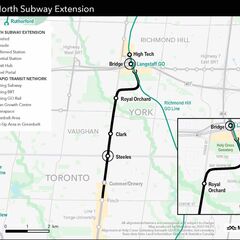Sorbara was the finance minister, not transpo, but I get your point. And I think you're right, this report does A LOT to undermine the caveats TTC put on not approving the Yonge extension. I'm curious to hear how Toronto responds to it; whether they say it's BS or raises interesting questions etc.
Hey, I didn't make up the number or toss out (like some here do) "Oh, I bet all this infrastructure will open up 30% capacity!" That's a number developed by some smart people.
Modelling is not an exact science but let's say it's only half that; 15% is still pretty impressive, isn't it? FWIW, to the extent you can trust modelling, I trust Metrolinx's over TTC's. Again, I thought the most interesting thing in the modelling is that they don't see significant uptick in going full RER with GO. I'm not the only one who's pointed out how little potential there is with that line simply because of how it goes into the Don Valley etc. but the idea that RH doesn't need a subway because of GO has been a consistent thread here so it's interesting to see it borne out in the data (I'm sure there's a more detailed report that comes with the powerpoint).
You keep hammering that 30% number, but you are ignoring a lot of key points from the study;
- 2015 Base, the Yonge Line is operating at 31200 pphpd, with a capacity of 28000 pphpd. 111% capacity utilization.
- By 2021, TTC expects that ATC & new trains will increase capacity to 36000 pphpd. This is the 30% that you mentioned.
However
- Population and employment growth to 2030 is expected to increase demand by 6600 pphpd
- By 2017, opening of the TYSSE is supposed to decrease demand by 1200 pphpd.
- By 2025, GO RER is expected to decrease demand by 4200pphpd
This brings the Yonge Line in 2031 to 32,300. 89% capacity utilization.
Yonge North is expected to increase this from 32,300, by 2400, to 34,700 pphpd. 96% capacity utilization.
You could technically say that the DRL is no longer necessarily holding back Yonge North, because Yonge North will not push the Yonge Line over capacity. But to me, that is a dangerous argument, as it will bring the line to to being close to overcapacity. It would erase the buffer that we have created with ATC and new trains to increase reliability of the line and put us into the same situation again.
I support the extension, but I think it would be a big mistake for it to go forward without subway network relief for the Yonge Line.



















